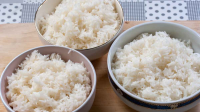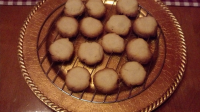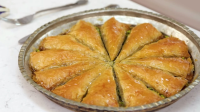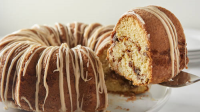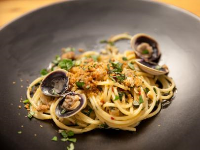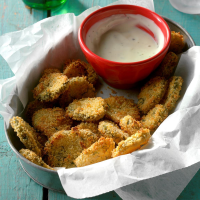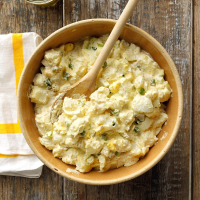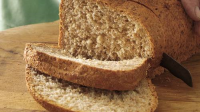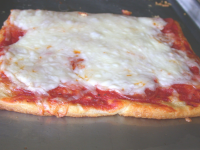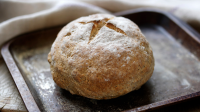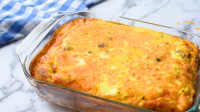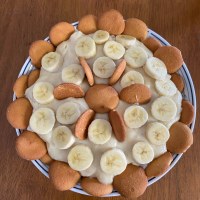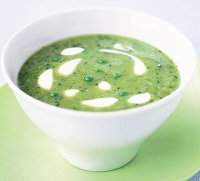CLASSIC SOURDOUGH BREAD | SOURDOUGH | RECIPES | DOVES F…
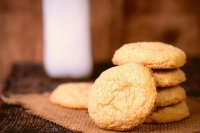
A sourdough loaf made with the simple basic ingredients of flour, water and a touch of salt. We used Einkorn to make the starter and ferment followed by strong white flour to make the dough. There are three distinct stages to making a sourdough loaf, the starter, the ferment and the dough itself. The starter will take 3 to 4 days to develop and then another 4–12 hours to be transformed into the ferment necessary to rise the dough. This bread is traditionally risen in a banneton which creates appealing lines on the baked loaf although it could be cooked in a regular loaf tin. The bread itself will have an appealing and complex sourdough taste and aroma. * Alternatively, use Organic Wholemeal Emmer, Organic Wholemeal Spelt Flour or Organic Wholemeal Rye Flour.* Before you begin to make your sourdough, we recommend reading our Guide to Sourdough Making alongside our handy Sourdough Starter Table.
Number Of Ingredients 15
Steps:
- Starter – use this handy chart to help you keep track of your feeding times. On the first day, put one tablespoon of flour and one of water into a 500ml glass bowl and mix together. Wet a clean tea towel, wring it out well, lay it over the bowl and leave in a warm place for about 12 hours. After the 12 hours have passed, add another tablespoon of flour and another of water, mix together, cover with the damp tea towel and leave for another 12 hours. On day two (24 hours since beginning your starter), stir in a third tablespoon of flour and a third spoon of water, stir to mix, cover again with the damp tea towel and leave in a warm place for 12 hours. For the second feed of day two, add a tablespoon of flour and one of water, stir to mix, cover with the tea towel and leave in a warm place for 12 hours. For the first feed of day three (36 hours since beginning your starter), increase the feed by adding two tablespoons of flour and two of water, stir to mix. Re-damp the tea towel if necessary, lay it over the bowl and leave in a warm place for 12 hours. On the second feed of day three, add one tablespoon of flour and another of water, mix together, cover with the damp tea towel and leave for another 12 hours. At this point your starter should be bubbly and ready to create your ferment. If the starter is not showing bubbles, repeat the 12-hour feed and water routine, and ensure the starter is kept in a warm place. Ferment Once your starter is bubbly, stir it and measure 50g of the starter into a large mixing bowl. Pour 150ml water into the bowl and stir until lump free. Add 100g flour and stir to mix. Invert a larger mixing bowl over the dough bowl and leave in a warm place for 4-12 hours until bubbles appear. When bubbly, your ferment is ready to use (you can either dispose of any unused starter after bread making or keep and feed it regularly until your next baking session). 1st Dough Pour the tepid water into the ferment and mix well. Add the flour to the ferment and stir to mix. While the dough is still craggy and lumpy, stir in the salt. Using your hands gather everything together, gently pressing into a ball of dough. Knead the dough in the bowl for 100 presses without adding flour. Invert a large bowl over the dough bowl and leave in a warm place until double in size which may take 4–12 hours. 2nd Dough Dust the inside of the banneton liberally with flour. Run a spatula around the edge of the swollen dough. Pour the oil onto the dough and dip your fingers in the oil. Pick up the dough on the far side of the bowl, gently pulling and stretching it upwards then fold it forward onto the dough still left in the bowl. Turn the dough a quarter to the left or right. Repeat the action of lifting and stretching the dough then folding back onto itself five or six times, turning the bowl each time. Tuck the edges of the dough under to make a ball of dough. Transfer the dough into the floured banneton with the smoothest side down. Cover with an upturned mixing bowl and leave to roughly double in size, 2-12 hours. Baking Pre-heat the oven 20 minutes before you are going to bake. Rub some oil around the inside of an oven tray or insert a baking liner. Remove the upturned bowl and very gently tip the dough onto the oven tray. Bake for 35-40 minutes until golden brown. Transfer the bread to a wire rack and leave to cool. Click this link to find a handy Sourdough Starter Chart which when printed has space for you to enter the day and time that you feed your starter with flour and water and to help monitor progress. This Guide to Sourdough Making contains lots of hints and tips for successful sourdough bread making.
BASIC SOURDOUGH BREAD RECIPE | SIMPLE HOMEMADE SOURDOUGH …

Provided by admin
Prep Time 30 minutes
Cook Time 30 minutes
Number Of Ingredients 16
Steps:
- Mix sourdough starter, flour, and salt together. Use enough water to make bread dough. (A moist dough is preferable to a dry dough.)
- Knead dough until it passes the “window pane test”: a small piece of dough will stretch between four fingers without breaking thin enough to allow light to pass through.
- Shape the dough into a loaf. Place in a pan or proofing basket, or on a board. Rub a little oil on the top surface of the dough and cover lightly with a towel or plastic wrap. Allow the dough to rise for 4-24 hours. If desired, a short (4-12 hours) proofing period can be used and the dough can be punched down, reshaped, and allowed to rise a second time, but a second proofing period is not required.
- Slice an X shape in the top of the loaf with a very sharp knife or razor blade.
- Bake at 400°F until the internal temperature reaches 210°F. (Use a meat thermometer inserted into the bottom or side of the loaf.) Bake 30-60 minutes (depending on loaf size). Cool before slicing.
More about "sourdough bread from starter recipes"
SOURDOUGH NO-KNEAD BREAD RECIPE - NYT COOKING
So you’ve brought a sourdough starter to life, or received one as a gift, or purchased one somewhere. You’ve fed it and watched it become bubbly and fragrant, with a light yeasty-boozy scent. Now it’s time to bake bread. An easy way to start is with this adaptation of the baker Jim Lahey’s storied recipe for no-knead bread, replacing commercial yeast with a little less than three-quarters of a cup of healthy, well-fed sourdough starter. Give the resulting dough a long, long rise and then plop it into a hot, enameled cast-iron pot with a lid. You’ll have an incredible loaf within the hour, and may well find yourself addicted to the smell, the taste and the process alike.
From cooking.nytimes.com
Reviews 4
Total Time P1D
Calories 259 per serving
From cooking.nytimes.com
Reviews 4
Total Time P1D
Calories 259 per serving
- Bake for about 25 to 30 minutes, then take the top off the pot and allow it to continue to cook until it is brown and crusty all over, an additional 20 minutes or so. Put the loaf on a rack to cool for at least 30 minutes before serving.
See details
SOURDOUGH BREAD | JAMIE OLIVER RECIPES
Making your own sourdough takes a bit of prep and know-how, but once you’ve got the knack and start developing your instincts, you’ll be hooked!
From jamieoliver.com
Total Time 50 minutes
Cuisine https://schema.org/LowLactoseDiet, https://schema.org/VeganDiet, https://schema.org/VegetarianDiet
Calories 160 calories per serving
From jamieoliver.com
Total Time 50 minutes
Cuisine https://schema.org/LowLactoseDiet, https://schema.org/VeganDiet, https://schema.org/VegetarianDiet
Calories 160 calories per serving
- The night before you want to bake, make the levain starter. Pour 50ml of tepid water into a large mixing bowl. Use your fingers to gently stir in the mature sourdough starter until fully dissolved, then repeat with the flour until smooth and combined.
- Leave, covered, in a warm place for at least 8 hours – it’s ready when lots of bubbles appear on the surface and the dough has a milky-sweet aroma.
- The next day, to make the final dough, pour 325ml of tepid water into a large mixing bowl and add 100g of the levain, which should float (the remaining levain can be fed and used as a new sourdough starter, or gifted to a friend). Use your fingers to gently stir it into the water until fully dissolved, then repeat with both flours. Cover with a damp cloth and rest in a warm place for 1 hour.
- Now add the salt and 25ml of tepid water, scrunching them into the dough until fully combined. Set aside, covered, in a warm place for 30 minutes.
- Wet your hand slightly and give the dough four folds in the bowl, one at each ‘corner’. This is one turn. Repeat this process another three times at 30-minute intervals, turning the dough four times in total across 2 hours. After the last turn, cover and leave to rise in a warm place for another 2 hours.
- To shape the loaf, tip the dough onto a clean surface and gently dust the top with a handful of semolina flour. Roughly shape into a round, being careful to keep as much air in the dough as possible. Rest, covered, for 30 minutes.
- Dust a basket or cane banneton with semolina flour (or you can simply use a medium bowl lined with a clean, floured tea towel). Lightly flour the dough again and flip it over, so the flour side is on the worktop. Set the dough in front of you and gently shape into a round. Turn the dough over, then place it in your floured basket, banneton or tea towel-lined bowl.
- Cover the dough with a shower cap (or oiled cling film) and allow to rest for 1 to 2 hours, or until increased in size by a quarter and looking bubbly. Transfer your dough, in its basket or bowl, to the fridge to rise for another 12 to 16 hours, or until bubbly and risen by another quarter.
- Place a heavy lidded casserole pot on the bottom shelf of the oven, then preheat to full whack (240ºC/464ºF/gas 9).
- Bring your loaf out of the fridge and scatter semolina over the top. Working carefully, remove the hot pot from the oven, take off the lid and gently tip your dough out into the pot, so now the pattern should be the right way up. Score it with a sharp knife, holding it at a 40 degree angle to the surface of the dough for the best slashes, then carefully cover and return to the oven.
- Reduce the temperature to 230ºC/446ºF/gas 8 and bake for 30 minutes. Carefully remove the lid and bake for a final 20 minutes, or until a malted golden brown. Remove to a wire rack to cool.
See details
CLASSIC SOURDOUGH BREAD | SOURDOUGH | RECIPES | DOVES F…
A sourdough loaf made with the simple basic ingredients of flour, water and a touch of salt. We used Einkorn to make the starter and ferment followed by strong white flour to make the dough. There are three distinct stages to making a sourdough loaf, the starter, the ferment and the dough itself. The starter will take 3 to 4 days to develop and then another 4–12 hours to be transformed into the ferment necessary to rise the dough. This bread is traditionally risen in a banneton which creates appealing lines on the baked loaf although it could be cooked in a regular loaf tin. The bread itself will have an appealing and complex sourdough taste and aroma.
* Alternatively, use Organic Wholemeal Emmer, Organic Wholemeal Spelt Flour or Organic Wholemeal Rye Flour.*
Before you begin to make your sourdough, we recommend reading our Guide to Sourdough Making alongside our handy Sourdough Starter Table.
From dovesfarm.co.uk
Reviews 4.9
From dovesfarm.co.uk
Reviews 4.9
- Starter – use this handy chart to help you keep track of your feeding times. On the first day, put one tablespoon of flour and one of water into a 500ml glass bowl and mix together. Wet a clean tea towel, wring it out well, lay it over the bowl and leave in a warm place for about 12 hours. After the 12 hours have passed, add another tablespoon of flour and another of water, mix together, cover with the damp tea towel and leave for another 12 hours. On day two (24 hours since beginning your starter), stir in a third tablespoon of flour and a third spoon of water, stir to mix, cover again with the damp tea towel and leave in a warm place for 12 hours. For the second feed of day two, add a tablespoon of flour and one of water, stir to mix, cover with the tea towel and leave in a warm place for 12 hours. For the first feed of day three (36 hours since beginning your starter), increase the feed by adding two tablespoons of flour and two of water, stir to mix. Re-damp the tea towel if necessary, lay it over the bowl and leave in a warm place for 12 hours. On the second feed of day three, add one tablespoon of flour and another of water, mix together, cover with the damp tea towel and leave for another 12 hours. At this point your starter should be bubbly and ready to create your ferment. If the starter is not showing bubbles, repeat the 12-hour feed and water routine, and ensure the starter is kept in a warm place. Ferment Once your starter is bubbly, stir it and measure 50g of the starter into a large mixing bowl. Pour 150ml water into the bowl and stir until lump free. Add 100g flour and stir to mix. Invert a larger mixing bowl over the dough bowl and leave in a warm place for 4-12 hours until bubbles appear. When bubbly, your ferment is ready to use (you can either dispose of any unused starter after bread making or keep and feed it regularly until your next baking session). 1st Dough Pour the tepid water into the ferment and mix well. Add the flour to the ferment and stir to mix. While the dough is still craggy and lumpy, stir in the salt. Using your hands gather everything together, gently pressing into a ball of dough. Knead the dough in the bowl for 100 presses without adding flour. Invert a large bowl over the dough bowl and leave in a warm place until double in size which may take 4–12 hours. 2nd Dough Dust the inside of the banneton liberally with flour. Run a spatula around the edge of the swollen dough. Pour the oil onto the dough and dip your fingers in the oil. Pick up the dough on the far side of the bowl, gently pulling and stretching it upwards then fold it forward onto the dough still left in the bowl. Turn the dough a quarter to the left or right. Repeat the action of lifting and stretching the dough then folding back onto itself five or six times, turning the bowl each time. Tuck the edges of the dough under to make a ball of dough. Transfer the dough into the floured banneton with the smoothest side down. Cover with an upturned mixing bowl and leave to roughly double in size, 2-12 hours. Baking Pre-heat the oven 20 minutes before you are going to bake. Rub some oil around the inside of an oven tray or insert a baking liner. Remove the upturned bowl and very gently tip the dough onto the oven tray. Bake for 35-40 minutes until golden brown. Transfer the bread to a wire rack and leave to cool. Click this link to find a handy Sourdough Starter Chart which when printed has space for you to enter the day and time that you feed your starter with flour and water and to help monitor progress. This Guide to Sourdough Making contains lots of hints and tips for successful sourdough bread making.
See details
SOURDOUGH RYE BREAD (WITH 100% RYE FLOUR) ⋆ MY GERMAN …
25/1/2020 · Please help, i love rye bread and your recipe seems nice and easy. I did try making your recipe, however these are what i added Black strap molasses (being vegan) and i thought i could give it a bit of a rise so i added 3/4 tsp of baking powder It was very sour and i had to discard the bread. My SD starter was nicely bubbly, but the bread …
From mygerman.recipes
From mygerman.recipes
See details
MY TOP 3 LEFTOVER SOURDOUGH STARTER RECIPES | THE PERFECT L…
27/2/2015 · My top 3 leftover sourdough starter recipes are all easy and delicious. Don't let your starter go to waste, make incredible waffles, pancakes, and banana bread!
From theperfectloaf.com
From theperfectloaf.com
See details
60+ ZERO WASTE SOURDOUGH STARTER DISCARD RECIPES - NO ...
31/3/2021 · Dried sourdough starter discard can be revived for bread baking or recipe use later. Additionally, it can be ground up and used as batter or bread crumb coating for certain recipes. Tips for Dehydrating Sourdough …
From nowastenutrition.com
From nowastenutrition.com
See details
ARTISAN SOURDOUGH BREAD MADE WITH A STIFF STARTER | KING ...
This bread has it all: great sourdough flavor, an open crumb, and a wonderfully crisp crust. Before you make this bread, you need to create a slightly different starter from your existing sourdough starter; please read our Stiff Sourdough Starter …
From kingarthurbaking.com
From kingarthurbaking.com
See details
SOURDOUGH STARTER RECIPE WITHOUT YEAST: MAKE YOUR OWN …
14/5/2020 · Sourdough baking is as old as bread baking itself. Before the widespread manufacturing of commercial yeast, nearly all rural bread bakers would have utilized either a sourdough starter or a natural leavening from beer brewing or other sources to make sourdough bread …
From attainable-sustainable.net
From attainable-sustainable.net
See details
SOURDOUGH - WIKIPEDIA
Sourdough baking has a devoted community today. Many devotees share starters and tips via the Internet. Hobbyists often proudly share their work on social media. Sourdough cultures contain communities of living organisms, with a history unique to each individual starter…
From en.m.wikipedia.org
From en.m.wikipedia.org
See details
OVER 30 SOURDOUGH RECIPES TO MAKE WITH A SOURDOUGH STARTE…
17/6/2019 · If you’ve ever made your own sourdough starter from wild yeast for making homemade sourdough bread you’ve probably found yourself wondering what else you can use it for besides just bread. And if you’ve been maintaining a sourdough starter …
From ourheritageofhealth.com
From ourheritageofhealth.com
See details
AMISH FRIENDSHIP BREAD STARTER RECIPE {HINTS FOR STORING ...
24/1/2017 · Use this Amish Friendship Bread Starter Recipe as a base for many sweet breads, dinner rolls, muffins and other baked goods. Hints for storing and using up the sourdough starter. Download the Amish Friendship Bread Starter instructions here. Click here to see how to bake the friendship bread…
From tastesoflizzyt.com
From tastesoflizzyt.com
See details
SAN FRANCISCO SOURDOUGH BREAD RECIPE | ALLRECIPES
I made this bread today using the sourdough starter from Esther. It was awesome!! The rising took more than an hour but who cares! The bread was …
From allrecipes.com
From allrecipes.com
See details
10 BEST SOURDOUGH BREAD WITHOUT STARTER RECIPES | YUM…
2/2/2022 · Sourdough Bread without Starter Recipes 63,976 Recipes. Last updated Feb 02, 2022. This search takes into account your taste preferences. 63,976 suggested recipes. Sourdough Bread KitchenAid. kosher salt, unbleached all purpose flour, yeast, water, honey. Sourdough Bread …
From yummly.com
From yummly.com
See details
HERMAN SOURDOUGH STARTER RECIPE | ALLRECIPES
This is a recipe for a sweet sourdough starter known as Herman. There are a number of things that can be made from it. It will take 15 days for the starter to …
From allrecipes.com
From allrecipes.com
See details
CHEF JOHN'S SOURDOUGH STARTER | ALLRECIPES
Create your own natural sourdough starter using just bread flour and water. It takes 10 days until it's ready to use, and Chef John gives feeding instructions for keeping your starter …
From allrecipes.com
From allrecipes.com
See details
EXTRA-TANGY SOURDOUGH BREAD | KING ARTHUR BAKING
The signature sourdough flavor comes from a combination of lactic and acetic acids, created as the dough rises and ferments. Refrigerating the dough encourages the production of more acetic acid, which is the tangier of the two. Thus, this bread with its refrigerated starter …
From kingarthurbaking.com
From kingarthurbaking.com
See details
BEGINNER BASIC SOURDOUGH STARTER RECIPE USING YEAST
26/2/2021 · Once the starter has had a chance to bubble up and grow more yeast, you can use it in sourdough bread recipes. A sourdough starter can be kept alive for months or even years with proper care. Remember, yeast is a living organism, and this starter …
From thespruceeats.com
From thespruceeats.com
See details
SOURDOUGH RECIPES - FARMHOUSE ON BOONE
Farmhouse on Boone sourdough recipes are the perfect way to start adding traditionally prepared whole grains to your family's diet. Some of our favorites, and most used recipes in the farmhouse, are the sourdough pancakes, easy sourdough pizza crust, sourdough English muffins and sourdough …
From farmhouseonboone.com
From farmhouseonboone.com
See details
10 BEST SOURDOUGH BREAD WITHOUT STARTER RECIPES | YUM…
2/2/2022 · Sourdough Bread without Starter Recipes 63,976 Recipes. Last updated Feb 02, 2022. This search takes into account your taste preferences. 63,976 suggested recipes. Sourdough Bread KitchenAid. kosher salt, unbleached all purpose flour, yeast, water, honey. Sourdough Bread …
From yummly.com
From yummly.com
See details
SOURDOUGH RYE BREAD (WITH 100% RYE FLOUR) ⋆ MY GERMAN …
25/1/2020 · Please help, i love rye bread and your recipe seems nice and easy. I did try making your recipe, however these are what i added Black strap molasses (being vegan) and i thought i could give it a bit of a rise so i added 3/4 tsp of baking powder It was very sour and i had to discard the bread. My SD starter was nicely bubbly, but the bread …
From mygerman.recipes
From mygerman.recipes
See details
60+ ZERO WASTE SOURDOUGH STARTER DISCARD RECIPES - NO ...
31/3/2021 · Dried sourdough starter discard can be revived for bread baking or recipe use later. Additionally, it can be ground up and used as batter or bread crumb coating for certain recipes. Tips for Dehydrating Sourdough …
From nowastenutrition.com
From nowastenutrition.com
See details
ARTISAN SOURDOUGH BREAD MADE WITH A STIFF STARTER | KING ...
This bread has it all: great sourdough flavor, an open crumb, and a wonderfully crisp crust. Before you make this bread, you need to create a slightly different starter from your existing sourdough starter; please read our Stiff Sourdough Starter …
From kingarthurbaking.com
From kingarthurbaking.com
See details
SOURDOUGH STARTER RECIPE WITHOUT YEAST: MAKE YOUR OWN …
14/5/2020 · Sourdough baking is as old as bread baking itself. Before the widespread manufacturing of commercial yeast, nearly all rural bread bakers would have utilized either a sourdough starter or a natural leavening from beer brewing or other sources to make sourdough bread …
From attainable-sustainable.net
From attainable-sustainable.net
See details
OVER 30 SOURDOUGH RECIPES TO MAKE WITH A SOURDOUGH STARTE…
17/6/2019 · If you’ve ever made your own sourdough starter from wild yeast for making homemade sourdough bread you’ve probably found yourself wondering what else you can use it for besides just bread. And if you’ve been maintaining a sourdough starter …
From ourheritageofhealth.com
From ourheritageofhealth.com
See details
AMISH FRIENDSHIP BREAD STARTER RECIPE {HINTS FOR STORING ...
24/1/2017 · Use this Amish Friendship Bread Starter Recipe as a base for many sweet breads, dinner rolls, muffins and other baked goods. Hints for storing and using up the sourdough starter. Download the Amish Friendship Bread Starter instructions here. Click here to see how to bake the friendship bread…
From tastesoflizzyt.com
From tastesoflizzyt.com
See details
SAN FRANCISCO SOURDOUGH BREAD RECIPE | ALLRECIPES
I made this bread today using the sourdough starter from Esther. It was awesome!! The rising took more than an hour but who cares! The bread was …
From allrecipes.com
From allrecipes.com
See details
















